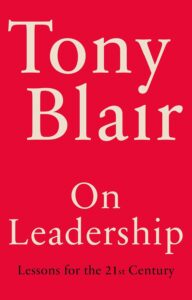 Reviewed by Canon Mike D Williams
Reviewed by Canon Mike D Williams
Leadership is a journey. This book is a disjointed journey of 40 short chapters. There are some interesting insights but too often the chapter stops just when you want it to go deeper. In short – a very frustrating read.
The target audience for this book is the ‘Leader’ of nations (note the capital L). Much of it is addressed to the needs of political leaders and the challenges they face. It is in seven parts ranging from taking power, delivery, policy, the technical revolution, foreign policy, communications and the leader themselves.
The general reader does gain insights from Blair’s experience as Prime Minister and the subsequent twenty years advising other world leaders. There is considerable overlap and just when a chapter gets interesting it finishes.
Blair reckons that it takes “ten years to change a country – fifteen is better and twenty optimum.” Just as he begins to consider how that is possible in a democratic system with short election cycles, he moves on to the need to make the centre strong. By that he means capable of making change happen, namely a strong centre of power for the Leader, which in his case came about with the Prime Minister’s Delivery Unit. Yet instead of developing that he delves into the importance of the leader’s schedule and how to handle the many demands on the leader’s time and attention. The concept of Cabinet Government does not get a mention!
The idea that failure to deliver on things like immigration feeds populism is mentioned but no further insights other than the leader has responsibility to deliver. There are nuggets of wisdom in relation to how developing countries can take big steps to improve governance and their economies, but the thoughts are not developed.
Perhaps most interesting is that Blair now sees the technological revolution and AI as “THE issue of our times”. “It should DOMINATE the political debate”. Yes, he does use capital letters! He would love to be back in power and be part of the technological revolution.
When he turns to foreign policy there is clarity about his strategy to be America’s closest ally as it serves Britain’s deep interests and how maintaining that position “hurt politically”. The importance of personal relationship built on trust with foreign leaders gets a chapter but no mention of the diplomatic efforts of civil servants and other ministers. Foreign policy is domestic policy in the sense that the rivalry between America and China spills over into domestic politics. The complexity of the world means that the ‘Leader’ will have to drive the policy.
A wide-ranging overview of issues that a national ‘Leader’ needs to pay attention to. It talks of operational issues and broad principles. But it lacks the intellectual wisdom of Henry Kissinger’s study on ‘Leadership’. Blair whilst in office was accused of operating a presidential model of government. He sees himself as a ‘Leader’ and this book reflects his mode of operating. Teams get mentioned but largely they exist to serve the Leader. Interesting in places but not recommended.